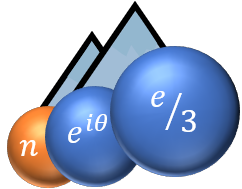Generically, edges of fractional quantum Hall (FQH) systems involve multiple modes. Furthermore, for a majority of fractions, there are counterpropagating modes on the edge. On the experimental side, there are major advances in the last few years in engineering such systems and exploring their transport characteristics. In this talk, I will review recent theoretical and experimental progress on understanding transport properties of such complex edges. Our theory [1] predicts a crossover between distinct quantized values for two-terminal electrical and thermal conductances (determined by the bulk topology) for coherent (non-equilibrated) and equilibrated regimes. These predictions were confirmed experimentally, both for electric [2] and thermal [7,10] conductance. Another important observable is electric shot noise on the edge. We show—both theoretically and experimentally [3,4,8,9]—that noise is an effective tool to study the thermal transport and the topology of the state. For strong inter-mode interaction, the thermal equilibration length turns to be much longer than the electric one, implying a broad regime with partial (electric but not thermal) equilibration [7,8,9]. We also extend the theory to transport through quantum point contacts (QPC), assuming electric equilibration on boundaries between the bulk and QPC regions [6]. The theory predicts intermediate quantized plateaus in electric conductance, accompanied by strong noise, as observed in experiments. Combination of theoretical and experimental progress paves the way also for better understanding the topology of FQH states, including non-abelian states such as 5/2 [5]. We further explore transport manifestation of binding transition, with a reduction of number of propagating edge modes by 2 that may take place for some fractions [11].
[1] I.V. Protopopov, Y. Gefen, A.D. Mirlin, Annals of Physics 385, 287 (2017).
[2] Y. Cohen, Y. Ronen, W. Yang, D. Banitt, J. Park, M. Heiblum, A.D. Mirlin, Y. Gefen, V. Umansky, Nature Communications 10, 1920 (2019).
[3] J. Park, A.D. Mirlin, B. Rosenow, Y. Gefen, PRB (RC) 99, 161302 (2019).
[4] C. Spånslätt, J. Park, Y. Gefen, A.D. Mirlin, PRL 123, 137701 (2019).
[5] J. Park, C. Spånslätt, Y. Gefen, A.D. Mirlin, PRL 125, 157702 (2020).
[6] C. Spånslätt, J. Park, Y. Gefen, A.D. Mirlin, PRB 101, 075308 (2020).
[7] S.K. Srivastav, R. Kumar, C. Spånslätt, K. Watanabe, T. Taniguchi, A.D. Mirlin, Y. Gefen, A. Das, PRL 126, 216803 (2021).
[8] R. Kumar, S.K. Srivastav, C. Spånslätt, K. Watanabe, T. Taniguchi, Y. Gefen, A.D. Mirlin, A.Das, Nature Communications 13, 213 (2022).
[9] R.A. Melcer, B. Dutta, C. Spånslätt, J. Park, A.D. Mirlin, V. Umansky, Nature Communications 13, 376 (2022).
[10] S.K. Srivastav, R. Kumar, C. Spånslätt, K. Watanabe, T. Taniguchi, A.D. Mirlin, Y. Gefen, A. Das, Nature Communications 13, 5185 (2022).
[11] C. Spånslätt, A. Stern, A.D. Mirlin, in preparation.

 PDF version
PDF version
